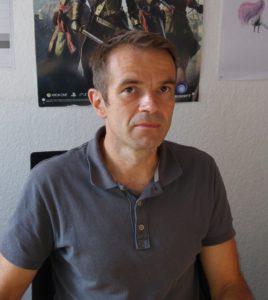
Blog
Machine Translation Report
What is the optimal MT Engine for you? Find out in the latest MT Report by Memsource.

We interviewed four of the top names in international game localization at Gamescom 2016. All work for multi-million-dollar game companies, and all are managers or heads of department. We probed them for their insights into the challenges, trends and changes they are currently facing, along with future predictions for the industry.
Attending Gamescom 2017 in Cologne? We’ll be there! Book a meeting with us.
Sarah Beuter - Head of Localization, Gameforge
‘If you want to be a game translator, play games’
What are the biggest challenges you’re currently facing?
Deadlines - we have really short deadlines because all of our games are in live operation and users want constant updates. Also the number of languages - we are doing up to 40 depending on the game. And finding skilled and reliable translators.
How do you overcome these challenges?
We’re going through a lot of processes and testing, but many challenges are interconnected. Finding reliable translators for those 40 languages is a struggle for example.
What do you think the top trends going into 2017 will be?
New languages - for us maybe Brazilian/ Portuguese. We’re always adding more and more. Also crowdsourcing - not new, but definitely a growing trend. And I think there will be better platforms for crowdsourcing emerging.
Any tips for other game localization professionals?
Play games. Lots of people who want to be game translators or game professionals are like- “I like games!”, but they don’t actually play them. Especially as a game translator you need to understand the language the players speak.
Ghulan Khan - Head of QA and Localization, Sega
‘We’ve recently started translating into Greek, Hungarian and Turkish’

Can you give some examples of non-language related things you would have to change for a particular region?
In Germany for example, no Nazi symbolry is allowed in games, and blood & gore needs to be toned down. Also changing the names of characters and items to make them more culturally relevant.
How do you assess what cultural changes need to be made?
We use native feedback from target territories; translation, testing, general knowledge to help us ensure it’s all culturally appropriate. We also pay attention to regional laws, eg there are some laws that apply in Germany but not in other territories.
Can you think of a time you localized into a language and it was a massive failure?
No, however it used to be traditional to always localize into what we considered ‘core’ territories like Spain and Italy, whereas some of those ‘core’ territories’ are more of a considered decision these days. By the same token other new territories are now being considered as more core.
Was there an obvious turning point when you realized Italian and Spanish weren’t such good options?
No, it was an accumulation of sales data over a period of time.
If machine translation became 99% perfect, how would that affect the localization industry?
I think it would give us more time to get the details really perfect rather than just focus on the basics.
You don’t think it could ever replace the localization industry?
I think it could supplant it, but I don’t think it would fully replace it, no. I would never fully rely on it without some kind of human interaction.
Lukas Kotrly - International Release and Localisation Manager, Deep Silver
‘The rise of the Asian languages will be one of the big trends of 2017’

What are the top challenges you’re currently facing?
Timing, budgeting and consistency. Projects are driven by timelines rather than quality. It would be best to have one translator to do the whole game, but we are often forced or pushed to use teams of 4, 5 or 6 people in order to meet the deadlines. We are definitely not following the optimal case scenario.
Has time pressure always been a problem in localization or is it more of a new problem?
It is a new problem, and actually a good one as it is connected with increasing demand for our services in general and having more products.
You said consistency. Do you mean consistency of quality?
Consistency of quality and terminology. This is connected with point number one, i.e. being forced to have teams of 4-5 translators. Even though we’re using all the CAT tools necessary, it requires lot of effort to have a game translated in one consistent style. Style itself can still only be checked by a human; this is an ongoing fight.
Any tips for game localization professionals that are not as experienced as yourself?
Don’t be afraid of technology, and localize in the country you’re localizing into. If a Spanish translator is needed, use a Spanish guy living in Madrid or Valencia. Not an expat living in Prague for example, slowly forgetting the Spanish nuances.
Is that a big problem? If you had a Spanish translator living in France, you wouldn’t trust him as much?
No, I would trust the Spanish guy in Spain more. Because I see it happening to me; I’ve lived abroad for 12 years and my Czech has deteriorated
Why the rise in Asian languages?
In general it’s easier to publish and be present these days in markets like China or Korea, which used to be quite isolated and insular. With China for example, the Chinese government is much more open, they don’t cut the games as much, and they don’t stop them being published in various regions. They are more open in general.
What other trends do you predict for 2017?
Extensive use of CAT Tools and other technologies; I think we’re slowly moving away from human translation to a hybrid model. Technology and tools help a lot. Also more and more competition – same as every year!
Stefan Dinger - Head of localization, Ubisoft
‘German is 30% longer than English; sometimes you have to delete part of a sentence because it does not fit’
What are the biggest challenges you’re currently facing?
Very big productions start with the translation process much earlier than they used to, meaning we usually work with texts that haven’t been finalized yet. This often means we have to re-translate and update various passages multiple times because they’re being modified constantly, and it can be very challenging to fit those updates into the project schedule. On the other hand, it is very motivating to be part of the development process and to have a deeper insight into the next blockbuster from the beginning. It also allows us to work on a global glossary that other departments like Marketing or PR can use.
What do you think the top trends will be going into 2017?
New terminology for the VR devices. Each device has special terminology; for example PS4 terminology for the buttons and hardware is different to that of the XBox, and it will be the same for the new devices.
Do you have any tips for Localization specialists in the gaming industry?
Read what you’ve written. We use a lot of text-to-speech to verify our translations and find sentences that sound weird/ spelling mistakes. The computer tells you what you have really written as opposed to what you thought you had written. It’s very helpful.
Do you think game localization is very different to other types of localization?
Yes, because it is much more diverse than for other products. The context and the text style is different for every game. For example, we translated the rhymes for Child of Light, a very artsy kind of game, and even invented a “new” fictive speech for the German faction of the adventure game Valiant Hearts. Sometimes you don’t have all the information you need, so you have to guess and use your expertise to get the translation right, and also to bring the right vibe. Compared to movie localization, you often have to produce lip syncs without seeing any lips or the cut-scenes for which they have to be recorded. You only have the audio file of the original actor as a reference point. And finally the volume is much higher; while for a film or a movie you have about 10-15 thousand words to translate, it can be up to 400,000 for a video game.
Click here to read how Nordeus continuously update _Top Eleven Football Manager _into 30+ languages
by James Austin
 James Austin is a Prague-based content developer for Memsource, musician and fitness enthusiast.
James Austin is a Prague-based content developer for Memsource, musician and fitness enthusiast.




